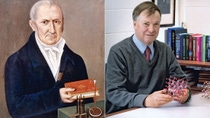Media
The chemistry of apples
Wild apples have been growing for millions of years and there is evidence that they were cultivated in Asia as early as 4,000 years ago. From there, apples spread across the world and gained a reputation as a healthy food – and for good reason: A “fruit pharmacy” is lurking in and just below the peel.

The water molecule H2O is one of around 300 substances contained in an apple.
It is said that a falling apple inspired Isaac Newton circa 1660 to come up with his revolutionary idea of gravity. Today, apples are the world’s most cultivated fruit – and still a source of inspiration for scientists, for example, because of the wealth of substances they contain.
An apple contains nearly all of the vitamins that humans need for their metabolic processes, including E 101 and E 300. Riboflavin (E 101), also known as vitamin B2, is a natural dye and is important for protein and energy metabolism. Ascorbic acid (E 300) is better known as vitamin C and is one of the most effective antioxidants. On average, 100 grams of apple contain 12 percent of the recommended daily intake of Vitamin C.
As well, minerals and trace elements based on calcium, magnesium, sulfur, phosphorus and chlorine are found in apples. Even just one small apple provides around one-tenth of your daily potassium requirement – this is good for fitness and concentration and helps to improve muscle tone. Munching on an apple also seems to help people lose weight. This slimming effect is attributed in part to the pectin contained in the apple – due to its water-binding properties, it makes you feel full faster.
Three-quarters of the valuable substances contained in an apple are found in or directly under the peel.
But what exactly is in and under the peel? Which chemical building blocks are contained in apples and what effects do they have? “The apple cells’ molecules are distinguished from each other by many factors, depending on variety, harvesting time and method. All apples have almost identical DNA sequences, but they differ from one variety to another,” says Luca Sebastiani, Professor of Horticultural Science at the Istituto di Scienze della Vita in Pisa, Italy. But one thing they have in common is that every apple is mostly (85 percent) made up of water and contains roughly 11 – 14 percent sugar, primarily fructose. Various other substances in the apple account for the remaining few percentage points. These include polyphenols as antioxidants, which are important for the apple. They are responsible for the color and aroma of the fruit, regulate the metabolic activities of the apple and protect it from damage, such as damage caused by intense solar radiation.
Rich in nutrients
People benefit from the same properties: The positive effect of antioxidants appears to help prevent illnesses such as asthma and cancer. More than 200 milligrams of these polyphenols can be contained in 100 grams of apple. One of these is the plant pigment quercetin, which is “being researched as a natural therapeutic agent against high blood pressure,” says Sebastiani’s colleague, Professor Rossella di Stefano, who is investigating therapies for cardiovascular illness at the University of Pisa. “Various studies on humans and animals have provided indications,” di Stefano adds, “that quercetin has a possible therapeutic role in the treatment of hypertension.”

Two-thirds of the effective antioxidants in an apple are contained in and just below the skin, so eating it unpeeled is a good idea. “All apple varieties are healthy and their consumption is important for humans’ well-being,” says Sebastiani. Apples are a great source of nutrients – even though the seeds contain amygdalin, which human metabolism turns into hydrocyanic acid. There is no risk of poisoning if you eat every part of the apple, but eating only the seeds is not advisable. Even just a small volume – around 10 grams of chewed apple seeds – can be harmful to the human body. One kilogram of apples can also contain as much as 20 milligrams of formaldehyde, the common name for the chemical compound methanal. Formaldehyde, like many other substances, is a necessary component for the metabolism of organisms – and not just of apples.
A great deal of research has been done, but the complex contents of the apple, their interaction and their effects still leave some scope for scientific activity. “More largescale, randomized and well-controlled human intervention studies are required to explore the potential mechanisms,” di Stefano says. For now, the fruit still holds some secrets under its red and green skin.


